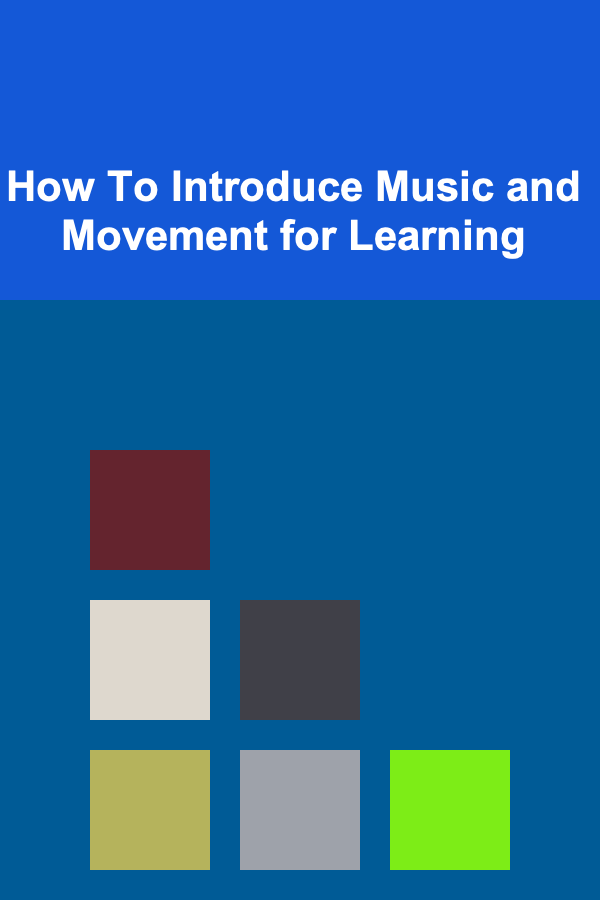
How To Introduce Music and Movement for Learning
ebook include PDF & Audio bundle (Micro Guide)
$12.99$10.99
Limited Time Offer! Order within the next:

In the ever-evolving landscape of education, teachers and researchers are increasingly exploring alternative methods to enhance learning and engagement. One such method that has gained significant traction is the integration of music and movement into the learning process. Whether it's using rhythmic patterns to reinforce math concepts, or employing dance to encourage creativity and collaboration, music and movement have proven to be powerful tools in the classroom. In this article, we will explore the benefits, methods, and strategies for introducing music and movement into educational settings to optimize learning outcomes.
The Benefits of Music and Movement in Learning
Before diving into how to introduce music and movement into the learning environment, it's essential to understand the profound impact these elements have on the brain and overall learning experience. The integration of music and movement in learning offers numerous cognitive, emotional, and social benefits.
1. Cognitive Development
Music and movement stimulate several areas of the brain responsible for processing different types of information. Studies have shown that incorporating music into education can improve memory, attention, and the ability to process complex concepts. When paired with movement, these benefits are amplified, as physical activity increases blood flow to the brain, encouraging enhanced focus and concentration.
For example, rhythmic exercises can reinforce memory, particularly in subjects like language and mathematics. The structure and pattern in music often mirror the structure of language or mathematical principles, which makes it easier for students to internalize these concepts. Additionally, music and movement can also enhance spatial-temporal skills, which are important for subjects like geometry, physics, and engineering.
2. Emotional Engagement and Motivation
Music has a unique ability to engage emotions. The emotional impact of music can motivate students, reduce anxiety, and increase self-confidence. This emotional engagement is critical for fostering a positive and motivating learning environment. Students who are emotionally connected to the material are more likely to retain information and engage deeply with the subject matter.
Movement, similarly, helps to release physical tension, reduces stress, and provides an outlet for excess energy, which can be particularly helpful in managing behavior and emotions in the classroom. Physical activity increases the production of endorphins, promoting a sense of well-being and creating a more conducive environment for learning.
3. Social Interaction and Collaboration
When music and movement are incorporated into group activities, they promote collaboration, teamwork, and communication. Group-based learning activities that include music and movement encourage social interaction and foster a sense of community among students. For example, a dance routine or musical performance requires students to work together, share ideas, and support one another, which strengthens their social skills and encourages respect for diversity.
Furthermore, these activities often create a shared experience that can help build stronger bonds among students. As they work together, students learn to negotiate roles, listen to each other, and make collective decisions---all of which are valuable life skills.
4. Physical Development
Engaging in movement not only aids in the cognitive and emotional aspects of learning but also supports physical development. Through activities like dance, exercise, and rhythmic movement, students improve their coordination, motor skills, and overall physical health. These physical benefits are essential, as they contribute to the holistic development of children.
Physical activity has been linked to improvements in physical endurance, motor skills, and overall fitness, which can also contribute to better academic performance. The connection between physical activity and academic achievement has led many schools to prioritize movement as part of their daily routine.
5. Creativity and Problem-Solving
Music and movement are often highly creative forms of expression. Introducing these elements into learning environments can foster creativity and encourage students to think outside the box. For instance, improvisational dance or music-making exercises allow students to experiment with new ideas, take risks, and explore different solutions to problems.
Creativity is a key component of problem-solving, and when students are given the freedom to create and innovate, they build important skills that they can apply in all areas of life. This creativity also enhances critical thinking and the ability to approach challenges from multiple perspectives.
Strategies for Integrating Music and Movement into Learning
Now that we have explored the benefits of music and movement, it's time to examine how to effectively incorporate them into the learning environment. Whether you are a teacher, a parent, or an educator looking to bring music and movement into your curriculum, there are several strategies and techniques you can employ.
1. Incorporating Rhythmic Activities in Lessons
Rhythmic activities are an effective way to introduce music into the classroom. These activities help students develop a sense of timing, pattern recognition, and coordination. Here are some examples of how to incorporate rhythm into various subjects:
- Mathematics: Use rhythmic clapping or stomping to reinforce multiplication tables or simple math facts. Rhythms can help students better internalize the concepts of addition, subtraction, and multiplication by turning them into songs or chants.
- Language Arts: Create rhythmic poems or chants to help students remember key concepts or vocabulary words. Singing or chanting specific phrases can improve pronunciation, fluency, and retention.
- Science: Use rhythmic movements or songs to teach scientific concepts, such as the water cycle or the classification of animals. Music can help break down complex scientific information into more digestible, memorable pieces.
2. Movement-Based Learning Activities
Movement can be incorporated into nearly every subject area to help students connect more deeply with the material. Here are a few ideas to get started:
- Math with Movement: Have students physically represent geometric shapes or use their bodies to demonstrate angles and lines. For example, ask students to form different shapes with their bodies to understand basic geometry.
- Social Studies with Movement: Use role-playing or drama to help students explore historical events or cultural practices. For example, students could act out different historical figures or participate in a mock election to better understand the political process.
- Language Arts with Movement: Incorporate dance or simple physical activities to reinforce literacy skills. For instance, students can act out scenes from a book to develop a deeper understanding of the characters, plot, and setting.
Movement doesn't have to be limited to structured activities either; it can be incorporated naturally into daily routines. For example, standing up to answer questions, moving around the classroom to engage with peers, or participating in interactive games can provide physical breaks that enhance focus and learning.
3. Use of Music to Set the Mood
Music can be used effectively to set the tone for different learning activities. The right type of music can help students focus, relax, or energize, depending on the nature of the lesson. Here are some examples:
- Focus and Concentration: Soft classical music or instrumental tracks can help students concentrate during individual work or study time. This music promotes a calm environment conducive to deep thinking and focus.
- Energy and Movement: Upbeat, fast-paced music is ideal for activities that require movement, such as dance, games, or collaborative group projects. This type of music helps increase energy levels and motivates students to participate actively.
- Relaxation and Reflection: Music with slow tempos, such as nature sounds or ambient music, can be used during quiet reflection or meditation time. This type of music helps students relax and process the information they have learned.
When selecting music, it is important to consider the preferences of the students and the context in which the music is being used. Music should enhance the learning experience, not distract from it.
4. Integrating Dance and Movement into Group Work
Group activities that combine dance and music can enhance social interaction, cooperation, and team-building skills. Here are a few ideas for using dance and movement in group settings:
- Collaborative Choreography: Assign students to create a group dance that tells a story or represents a specific concept they are learning about. For example, students can create a dance to demonstrate the steps of a scientific process or act out a scene from history.
- Movement as a Communication Tool: Encourage students to communicate through movement rather than words. This exercise helps students develop non-verbal communication skills and fosters creativity. It can also be used to represent emotions or abstract concepts.
- Group Music Creation: Allow students to work together to compose their own music or rhythm patterns. This encourages teamwork, creativity, and problem-solving, as students must collaborate and negotiate to create a cohesive musical piece.
5. Mindful Movement and Music for Stress Relief
Incorporating mindfulness exercises that involve music and movement can help students relax, refocus, and reduce stress. Simple exercises like stretching, deep breathing, or mindful walking, when combined with calming music, can provide students with tools to manage their emotions and improve their mental well-being.
Mindful movement activities are particularly beneficial for students who experience anxiety or struggle with attention issues. By integrating these activities into the school day, students can develop resilience and emotional intelligence, which are essential skills for academic success and personal development.
Overcoming Challenges and Ensuring Success
While the integration of music and movement into the classroom can be highly beneficial, there are challenges to consider. Some of the most common challenges include:
- Lack of Resources: Not all schools have access to musical instruments, dance studios, or specialized materials. However, music and movement can be incorporated with minimal resources, such as using online resources, simple instruments (like clapping or tapping), or even just the students' voices and bodies.
- Classroom Management: Movement activities can sometimes lead to disruptions if not managed effectively. It is important to establish clear expectations and guidelines for movement-based activities to ensure they are conducted in an organized and respectful manner.
- Time Constraints: Educators may feel that there is not enough time to integrate music and movement into their lessons, particularly with a packed curriculum. However, small adjustments---such as incorporating music for transitions or using movement as a warm-up---can still provide benefits without significantly altering the schedule.
To ensure the success of music and movement-based learning, it is essential to be flexible, creative, and resourceful. Teachers should experiment with different approaches, collaborate with colleagues, and continuously assess the effectiveness of their methods.
Conclusion
Introducing music and movement into learning is not only a fun and engaging way to enhance the educational experience, but it also has significant cognitive, emotional, and social benefits. By integrating music and movement into lessons, educators can foster a more dynamic, interactive, and holistic learning environment that nurtures creativity, problem-solving, and collaboration.
Incorporating these elements into the classroom is a powerful way to engage students and support their overall development. Whether it's through rhythmic exercises, movement-based group activities, or music to set the mood, there are countless opportunities to integrate music and movement into the learning process. With thoughtful planning, creativity, and a focus on student well-being, teachers can unlock the full potential of these tools to improve learning outcomes and create a more enjoyable, motivating, and enriching educational experience for all students.
Reading More From Our Other Websites
- [Tie-Dyeing Tip 101] How to Combine Tie‑Dye with Hand‑Embroidered Details for Unique Apparel
- [Weaving Tip 101] Frame Loom Basics: Getting Started with Hand‑Weaving at Home
- [Home Space Saving 101] How to Make the Most of Your Apartment's Limited Space
- [Home Rental Property 101] How to Conduct Effective Rental Property Inspections
- [Star Gazing Tip 101] The Life Cycle of Stars: From Birth in Nebulae to Supernovae and Black Holes
- [Organization Tip 101] How to Set Up a System for Tracking Rent Payments
- [Gardening 101] How to Create a Beautiful Native Plants Garden in Your Backyard
- [Home Budget Decorating 101] How to Illuminate Your Home Beautifully Without Overspending: A Guide to Affordable Lighting Fixtures
- [Organization Tip 101] How to Use Labels to Keep Minimalist Spaces Organized
- [Home Maintenance 101] How to Prevent Water Damage in Your Home's Basement

How to Stage a Small Apartment for Maximum Appeal
Read More
How to Stage Your Home for Buyers Who Work From Home
Read More
How to Use a Rolling Cart for Mobile School Supply Organization
Read More
Understanding the Role of Real Estate in FIRE (Financial Independence, Retire Early)
Read More
Photographing Solar Flares: Advanced Techniques
Read More
10 Tips for International Students: A College Application Checklist
Read MoreOther Products

How to Stage a Small Apartment for Maximum Appeal
Read More
How to Stage Your Home for Buyers Who Work From Home
Read More
How to Use a Rolling Cart for Mobile School Supply Organization
Read More
Understanding the Role of Real Estate in FIRE (Financial Independence, Retire Early)
Read More
Photographing Solar Flares: Advanced Techniques
Read More